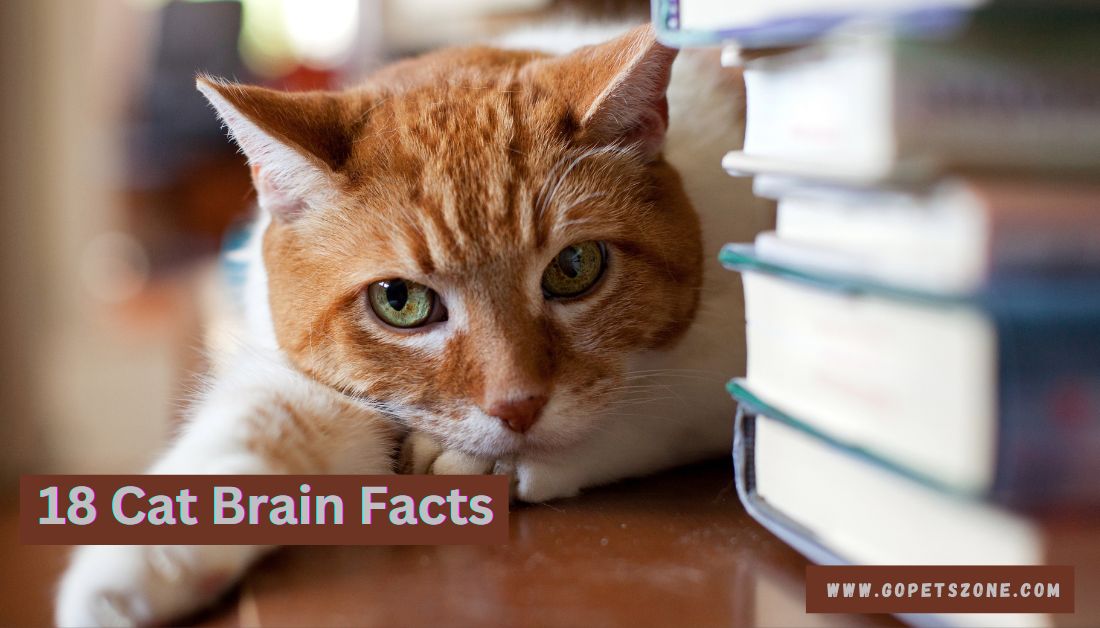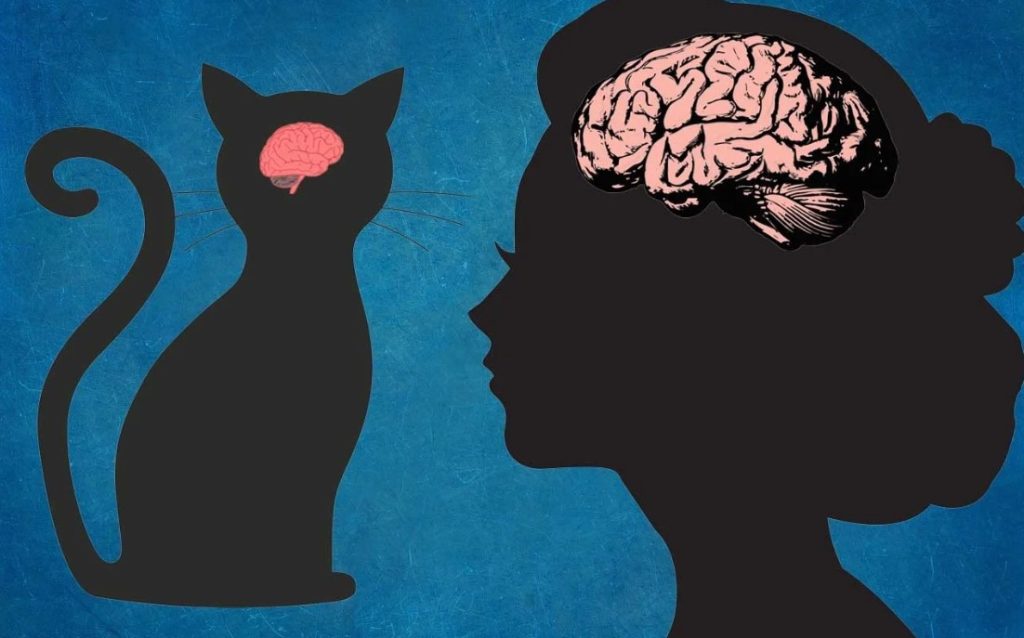18 Cat Brain Facts: You Have to Know

Do you have a cat? Have you ever wondered how your feline’s brain works? The cat’s brain is the most complex organ in its body—controlling everything from its reflexes to social interactions. It contains about 250 million neurons, or twice as many cells per gram of tissue, compared with humans’ brains.
The brains of humans and cats have many similarities. Each contains a cortex (the thinking part) and cerebellum (which controls motor function).
If you understand how a cat’s brain works, it will be easier to communicate with her. So we’ve listed some more exciting facts about the cat brain below. We think you’ll find them fascinating and even a little surprising!
We will share 18 surprising facts about cat brains that you probably never knew!
1. Human vs. Cat Brain

There are many differences between a human brain and a cat’s brain. A human brain weighs about 1,400 grams (3 lbs) and is more extensive in some respects than a cat’s brain.
The average human has 100 billion neurons in the cerebral cortex, which is five times more than the number of stars in our galaxy. The cerebral cortex is responsible for higher-order thinking, like language skills, planning, and problem-solving.
Cat Brain
- The brain is the most important organ in the human body. It makes up 2% of your total weight but uses 20% of your energy when resting.
- Cats have a total of 17 to 20 muscles in each ear, allowing them to move their ears independently and control their position in space.
- The weight of a cat’s brain can be determined by measuring the width of its skull. If you add up the widths of all three head sections (front, middle, and back), then divide by 2, you will get your answer. The average cat’s brain weight is about 3.8 ounces (106 grams).
2. Cat Brains Are Very Complex
The average brain has about 100 billion neurons, and each has at least 10,000 connections with other neurons. Your brain is constantly processing information and making decisions for you.
3. The Memory of Cats Is Not as Sharp as That of Humans
But it does not need to be. Your cat’s brain is designed for survival, which means it doesn’t have the same functions as yours. Cats have shorter attention spans than humans because they have fewer neurons in their brains and cannot focus on things for very long.
4. Cats Can Think Long-Term
Cats can think long-term. The average cat has a short-term memory of about 20 minutes, but it can also remember things for up to two years! That’s because their brain has more than 300 million neurons than any other animal.
5. Cats Don’t Feel Guilt or Remorse
They don’t have the same level of emotional complexity as humans. They don’t feel guilty about doing bad things and won’t apologize for them.
6. The Cat Brain Can Smell What’s Up
Cats have an incredible sense of smell. They can detect one part per trillion odors and can even tell what a mouse has been eating by sniffing its urine! Cats have about 200 million scent receptors in their noses- compared to 5 million for humans.
7. Cats Learn Faster than Dogs
Cats are much better at learning and remembering things than dogs. This is because they have a smaller brain and fewer neurons, meaning they can focus more on one thing at a time. They are also more independent than dogs, so they don’t need as many commands to stay safe.
8. Cats Dream as Humans Do
Cats do dream, and as a result, they sleep more deeply than humans. Cats also suffer from nightmares, which means they can have ‘bad dreams like humans. These bad dreams are usually caused by stress or anxiety in their lives.
9. Cats Are Very Good at Hiding Illnesses
Cats are masters of hiding when sick or in pain because they don’t want to be cuddled or petted. If you think your cat might be ill, watch for changes in behavior, such as sleeping more than usual or eating less food.
10. Cats Show Emotions in Almost the Same Way that Humans Do
Cats have many different ways of expressing their emotions. They can smile, show their teeth and make a variety of noises. They also have facial expressions, including raised eyebrows and ‘blinkies,’ where they shut their eyes tightly for a second or two.
11. Feline Eyes and Brains Work Together for Optimal Hunting
Cats can spot prey in the wild, even when it is camouflaged by their surroundings. This is because cats use their eyes and brains to spot their next meal.
While most animals only use one eye at a time for hunting, cats use binocular vision, which means they see with both eyes at once. This allows them to judge distances and depth more accurately than other predators.
12. Brain-Related Health Issues
Cats can get sick just like humans. Unfortunately, many of the same things that affect people’s brains can also affect cats. If your cat has a brain-related health issue, you may notice epilepsy, dementia, and Alzheimer’s disease symptoms.
13. Most Cats Can Read People’s Facial Expressions Better than Dogs Can
Cats are known for being able to read people’s facial expressions, but it turns out that they might be even better at it than dogs are. A study published in the journal Animal Cognition found that cats can read human facial expressions more accurately than dogs—a skill known as “theory of mind.”
14. Cats Recognize Their Owners’ Faces
Cats can recognize their owners’ faces, even when they aren’t looking at them. A study published in the journal Current Biology found that cats can use visual information to identify human faces—even when they have turned away from a person or presented with only part of their face.
15. They Recognize Their Names, Too
A study published in the journal Applied Animal Behaviour Science found that cats can learn to associate their names with a specific person. The researchers found that when they played recordings of cat owners saying “hello” and “bye-bye,” the cats responded more quickly to the former than the latter.
16. Cat Brains Are 90% Similar to Human Brains.
A 2014 study published in the journal PLOS ONE found that cats’ brains are more similar to human brains. Using MRI scans, researchers discovered that cats have the same number of neurons as a human brain—around 100 billion. But because their brains are smaller, they can fit more of them into their skulls.
17. They Can Solve Problems and Learn from Observation, Experience, or Trial and Error
Cats are intelligent creatures and can solve problems and learn from observation, experience, or trial and error. This is why many cat owners find their pets entertaining when they watch them play with toys, try out new things they’ve learned, or observe them as they do what they do best—be themselves!
18. Cats Know How To Control Their Owner’s Behavior
Cats know how to control their owner’s behavior, especially when they want something. They often use their cuteness and playfulness to get what they want from us. We must learn the art of saying “no” without hurting our feline friend’s feelings because they sometimes need to be told no.
Conclusion
We hope that you now have a better understanding of what your cat is thinking and why they do the things they do. Although we may not understand their thought process, we humans need to learn how to communicate effectively with our feline friends.
If you want to know more about cats, we have discussed cat ears, cat eyes, and some attractive characteristics of cats’ habits. More related cat facts lists are available for you to check out.
Learn More About Cats
- Top 60+ Police Themed Cat Names for Your Furry Officer
- Top 100+ Botanical Cat Names for Plant Lovers
- Top 60+ Adorable Potato Themed Cat Names
- Cat Paw Facts: Top 21 Exotic Facts About Cat Paws
- Top 10 Cat Intelligence Facts You Need to Know
- The 80 Best Facts About Ragdoll Cats!
FAQs- Cat Brain Facts
1. Can a Cat Remember You?
Ans: Yes, cats can remember some things for up to 16 hours. This depends on the cat and how much stress it’s feeling.
2. How Small Is a Cat’s Brain?
Ans: A cat’s brain weighs between 3 and 3.5 ounces (85-100 grams) and is about the size of a walnut. The average human brain weighs about 3 pounds (1.4 kg)
3. How Intelligent Is a Cat?
Ans: Cats are very intelligent animals. They can learn to play with toys, open doors, and even use the toilet by themselves. Cats can also be trained to perform tricks, such as fetching a ball or sitting on command.
4. How Fast Do Cats Forget You?
Ans: Cats have short-term memory, which means they forget things that happened just a few seconds ago. However, cats can remember where they bury their prey for up to three days.
5. Do Cats Have Memories?
Ans: Yes, cats have memories. They can remember things that happen to them and they can remember where they bury their prey for up to three days. Cats also have an incredible sense of hearing and smell.
